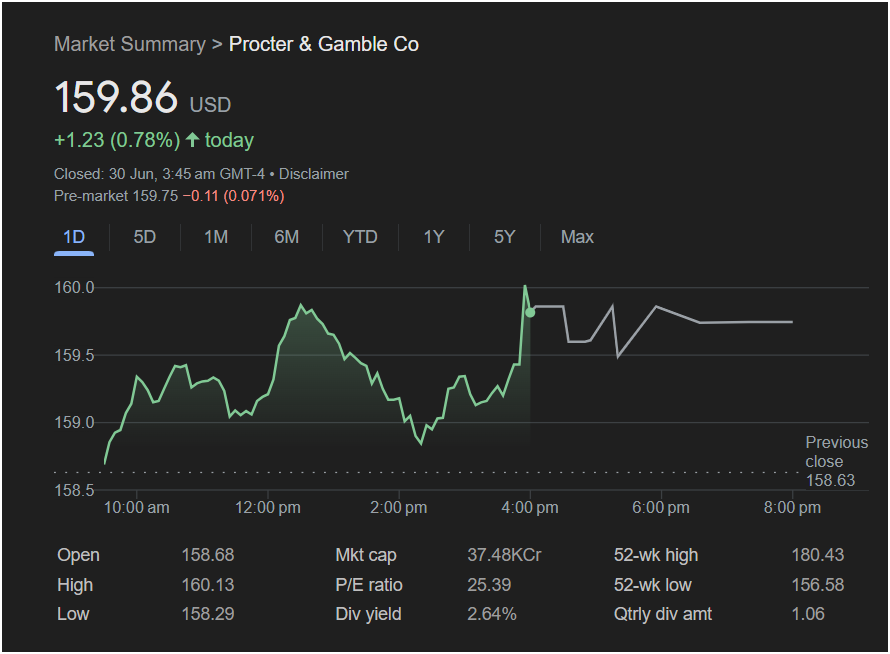Procter & Gamble Stock Spikes to $160: A Bottom Signal or Bull Trap for Monday

Procter & Gamble Co (NYSE: PG) stock ended the week with a volatile but ultimately positive session, leaving traders questioning whether the consumer staples giant has found a floor. The stock closed Friday at
1.23 (0.78%), but it was the dramatic late-day price action that captured everyone’s attention.
As investors position themselves for the week ahead, a detailed analysis of PG’s recent performance is crucial. Pre-market data shows a slight dip to $159.75, a minor loss of 0.11%, suggesting a quiet start to Monday may be in the cards. This article unpacks the key data to determine if now is the right time to invest.
Friday’s Rollercoaster Session
The intraday chart for Procter & Gamble reveals a fierce battle between buyers and sellers.
-
Steady Open: The stock opened at $158.68, slightly above the previous close of $158.63.
-
Midday Peak and Pullback: PG rallied through the morning to a peak just under $160 before sellers stepped in, pushing the price back down to a session low of $158.29 in the afternoon.
-
The 4 PM Spike: In a sudden burst of buying volume around the market close, the stock surged dramatically, hitting its high of the day at $160.13. It then settled just below that level to close at $159.86.
This late-day surge is a bullish sign, indicating that buyers had the final say. However, the failure to hold above the key $160 level into the close adds a layer of uncertainty.
Key Financial Metrics for P&G Traders
Understanding the fundamental backdrop is essential for any trade or investment in Procter & Gamble stock.
-
52-Week Range: This is the most critical metric right now. With a 52-week low of
180.43, the stock is currently trading very close to its annual low. This can either act as a strong support level or a sign of persistent weakness.
-
P/E Ratio: At 25.39, P&G has a reasonable valuation for a stable, blue-chip company. It doesn’t scream “overvalued,” but it isn’t a deep value play either.
-
Dividend Yield: This is a standout feature. With a robust dividend yield of 2.64% and a quarterly payout of $1.06 per share, PG is a favorite among income-oriented investors.
Outlook for Monday: Will the Stock Go Up or Down?
Given the proximity to the 52-week low and Friday’s volatile action, here are the potential scenarios for Monday.
The Bullish Case (A Potential Bounce):
The late-day spike suggests buyers see value at these levels. If the stock can gather momentum and decisively break and hold above Friday’s high of $160.13, it could confirm that the 52-week low area is acting as solid support. This could trigger a relief rally, with the next resistance levels around $162 and $165.
The Bearish Case (More Downside Possible):
The pre-market dip, although minor, shows a lack of immediate follow-through from Friday’s spike. If sellers regain control on Monday and push the price below Friday’s low of
156.58. A break below this critical support level would be a significant bearish development and could open the door to further declines.
Is It the Right Time to Invest in P&G Stock?
For the Short-Term Trader:
This is a high-risk, high-reward setup. The volatility around the
160.13** to go long or a break below $158.29 to consider a short position. Trading within this choppy range is not advisable until a clearer direction emerges.
For the Long-Term Investor:
For investors focused on income and stability, buying a “Dividend Aristocrat” like Procter & Gamble near its 52-week low is often considered a classic value strategy. The 2.64% dividend yield is attractive, providing a return while you wait for a potential price recovery. While the stock could drift lower in the short term, initiating a position at these levels could prove rewarding over a multi-year horizon for those with a long-term perspective.
Disclaimer: This article is for informational purposes only and is based on the analysis of the provided image. It does not constitute financial advice. All investment decisions should be made with the guidance of a qualified financial professional.


